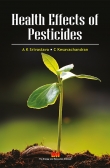Ecology and Environment
Book Details
The alarming rise in greenhouse gas and pollution level which has resulted in serious environmental and ecological harm is the biggest concern today. It has not only made the lives of mankind miserable but also threatens their very existence. The survival of human beings on Earth depends on the availability of clean environment. The nature can be protected only when there is a good understanding of the ecology. For this, young people and the general public have to become aware of the underlying issues associated with maintaining a clean environment and protecting the nature.
Ecology and Environment has delved in depth on the subject and brings a broad perspective of the various issues. Following the curriculum of University Grants Commission, the book covers different types of ecosystem on the earth. It deals with the effective and sustainable use of natural resources which includes water, forest, mineral resources in the ground and productive land. The book explains the population trends in the world and India, and how it is impacting the environment. The role of public participation in promoting environmental sustainability is explored too.
Table of Contents
- Multidisciplinary Nature of Environmental Studies
- Sustainable Ecosystems
- Natural Resources
- Biodiversity
- Population and its Impact
- Pollution, Sources, and Effects
- Social Issues and Public Participation to Minimize Impacts of Development
- Climate Change and its Impacts
- Environmental Legislation and Enforcement
- Education for Environmental Awareness
- Projects and Activities
- Indian and International Case Studies
Foreword
Preface
1.1 Humans and the Environment
1.2 Local to Global Scope of Environmental Issues
1.3 Definition, Scope, and Importance of Environmental Studies
2.1 Indroduction
2.2 Understanding Ecosystems
2.3 Ecosystem Functions
2.4 Producers and Consumers
2.5 Ecosystem Processes
2.6 Food Web
2.7 Influence of Humans on Ecosystems
2.8 Types of Ecosystems
2.9 Conclusion
3.1 Indroduction
3.2 Water Resources
3.3 Energy Resources
3.4 Mineral Resources
3.5 Forest Resources
3.6 Land Resources
4.1 What is Biodiversity?
4.2 Biodiversity in India
4.3 Species Diversity
4.4 Threatened Species in India
4.5 National Policy for Protection of Biodiversity
4.6 International Accords Helping India Support Biodiversity Protection
4.7 Invasive or Alien Species
5.1 World Population
5.2 India’s Population
5.3 Population Control
5.4 Malthusian Concepts on Population
5.5 Population Growth and its Impact on the Environment
6.1 Air Pollution
6.2 Water Pollution
6.3 Noise Pollution
6.4 Soil Pollution
6.5 Solid Waste Pollution
6.6 Disaster Management
7.1 Introduction: Embracing Sustainable Development for Social Change
7.2 Environmental Issues and Development: Energy and Water Conservation, Consumerism, and Waste Disposal
7.3 Government Involvement in Protecting the Environment
7.4 Non-governmental and Corporate Involvement in Protecting the Environment
7.5 Case Studies in Efforts to Promote Sustainability
7.6 Public Participation in Protecting the Environment
7.7 Conclusion
8.1 Introduction
8.2 Intergovernmental Panel on Climate Change
8.3 Effects of Climate Change on Humans
8.4 Prevention and Mitigation of Climate Change Impacts
9.1 Introduction
9.2 Laws for Environmental Management
10.1 Introduction
10.2 History and Purpose of Environmental Education
10.3 Actions and Ideas for Environmental Sustainability at Home
10.4 Fostering Environmental Education in an Academic Setting
10.5 Environmental Education in Your Community
10.6 Conclusion
11.1 Introduction
11.2 Nature Observation and Wildlife Appreciation Activities
11.3 Creating and Preserving Habitats for Wildlife and Green Space
11.4 Water Quality and Conservation
11.5 Environmental Health and Disease
11.6 Waste Management
11.7 Further Activities, Projects, and Resources for Green and Sustainable Living
11.8 Conclusion
12.1 Introduction
12.2 Love Canal: Birth of Hazardous Waste Site Clean-ups
12.3 Alang Shipyard
12.4 Bhopal Gas Tragedy
12.5 Chernobyl Nuclear Accident, Ukraine
12.6 Narmada Dam Controversy
12.7 Oil Spills and Impacts on the Environment
References
Index
Keywords
You may also like...
-
 Concerned Citizen Series (Set of 8 books)
Regular Price 2033.00
Concerned Citizen Series (Set of 8 books)
Regular Price 2033.00
-
Health Effects of Pesticides Regular Price 395.00
-
 Health Effects of Pesticides
Regular Price 395.00
Special Price 355.00
Health Effects of Pesticides
Regular Price 395.00
Special Price 355.00
-
 Arsenic Removal from Contaminated Groundwater
Regular Price 995.00
Special Price 896.00
Arsenic Removal from Contaminated Groundwater
Regular Price 995.00
Special Price 896.00


